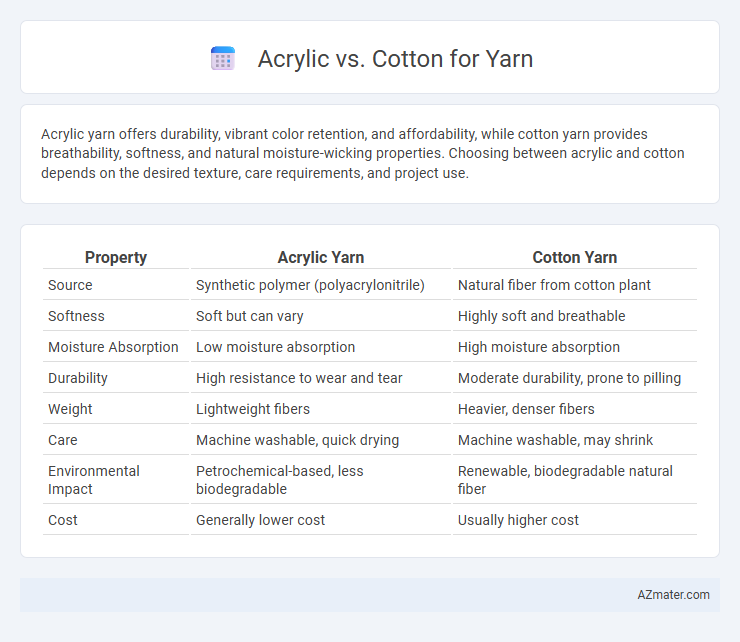Acrylic yarn offers durability, vibrant color retention, and affordability, while cotton yarn provides breathability, softness, and natural moisture-wicking properties. Choosing between acrylic and cotton depends on the desired texture, care requirements, and project use.
Table of Comparison
| Property | Acrylic Yarn | Cotton Yarn |
|---|---|---|
| Source | Synthetic polymer (polyacrylonitrile) | Natural fiber from cotton plant |
| Softness | Soft but can vary | Highly soft and breathable |
| Moisture Absorption | Low moisture absorption | High moisture absorption |
| Durability | High resistance to wear and tear | Moderate durability, prone to pilling |
| Weight | Lightweight fibers | Heavier, denser fibers |
| Care | Machine washable, quick drying | Machine washable, may shrink |
| Environmental Impact | Petrochemical-based, less biodegradable | Renewable, biodegradable natural fiber |
| Cost | Generally lower cost | Usually higher cost |
Overview: Acrylic vs Cotton Yarn
Acrylic yarn is a synthetic fiber known for its durability, affordability, and resistance to moisture, making it ideal for items requiring easy care and vibrant colors. Cotton yarn, a natural fiber, offers breathability, softness, and excellent moisture absorption, perfect for lightweight, comfortable garments and summer apparel. Both fibers serve distinct purposes in knitting and crocheting, with acrylic favored for resilience and cotton prized for natural comfort.
Composition and Characteristics
Acrylic yarn, composed of synthetic polymers like polyacrylonitrile, offers durability, resistance to moisture, and vibrant color retention, making it ideal for easy-care garments and accessories. Cotton yarn, derived from natural cotton fibers, provides breathability, softness, and excellent moisture absorption, favored for comfortable, hypoallergenic textiles. Both fibers differ significantly in texture and performance, influencing knitwear's warmth, elasticity, and maintenance requirements.
Softness and Texture Comparison
Acrylic yarn offers a smooth, consistent texture that is often softer than many cotton yarns, making it ideal for projects requiring a plush feel. Cotton yarn provides a natural, breathable texture with a slightly firmer hand, which enhances stitch definition but may feel less soft compared to acrylic. Choosing between acrylic and cotton depends on the desired softness level and texture, with acrylic generally preferred for softness and cotton favored for natural fiber benefits.
Durability and Longevity
Acrylic yarn offers superior durability and resistance to wear compared to cotton, making it ideal for projects requiring long-lasting fabrics. Cotton fibers tend to weaken and degrade faster over time, especially with frequent washing and exposure to moisture. Acrylic's synthetic composition enhances its resilience against stretching, fading, and pilling, ensuring extended longevity for knitted or crocheted items.
Ease of Care: Washing and Maintenance
Acrylic yarn offers superior ease of care with its machine-washable and quick-drying properties, making it ideal for low-maintenance projects. Cotton yarn, while soft and breathable, often requires hand washing and gentle handling to prevent shrinking or distortion. Choosing acrylic streamlines washing and maintenance, whereas cotton demands more careful care to preserve its natural fiber qualities.
Cost and Affordability
Acrylic yarn is generally more cost-effective and affordable than cotton yarn, making it a popular choice for budget-conscious crafters. Acrylic fibers are synthetic and mass-produced, resulting in lower prices compared to natural cotton, which requires more extensive cultivation and processing. While cotton yarn tends to be pricier due to its natural origin and breathability benefits, acrylic offers a wide range of colors and durability at a fraction of the cost.
Environmental Impact and Sustainability
Acrylic yarn, derived from synthetic polymers, has a significant environmental footprint due to its reliance on non-renewable petroleum resources and its non-biodegradable nature, leading to persistent microplastic pollution. In contrast, cotton yarn, although natural and biodegradable, involves substantial water consumption and pesticide use, which can contribute to soil degradation and water pollution if not managed sustainably. Organic and sustainably farmed cotton offers a more eco-friendly alternative, reducing chemical inputs and water usage, thus making it a preferable option for environmentally conscious textile production.
Best Uses: Project Suitability
Acrylic yarn excels in durability and vibrant color retention, making it ideal for projects like blankets, toys, and washable garments where easy care is essential. Cotton yarn offers superior breathability and natural fiber softness, perfect for summer wear, dishcloths, and home decor items that benefit from absorbency and a matte finish. Choosing between acrylic and cotton yarn depends on the project's need for warmth, texture, and maintenance requirements.
Color Variety and Availability
Acrylic yarn offers a broader color variety with vibrant, consistent shades due to its synthetic nature, making it ideal for projects requiring bold and diverse palettes. Cotton yarn, while more limited in color options, features natural, earthy tones and subtle variations that appeal to those seeking a more organic aesthetic. Acrylic yarn is widely available in most craft stores and online, whereas cotton yarn availability can vary based on quality and organic certification.
Final Verdict: Choosing the Right Yarn
Acrylic yarn offers affordability, vibrant colors, and easy maintenance, making it ideal for projects requiring durability and stain resistance. Cotton yarn provides breathability, softness, and natural fiber benefits, perfect for lightweight, breathable garments and summer wear. Selecting the right yarn depends on project requirements, with acrylic best for budget-friendly, long-lasting pieces and cotton favored for comfort and natural fiber qualities.

Infographic: Acrylic vs Cotton for Yarn
 azmater.com
azmater.com